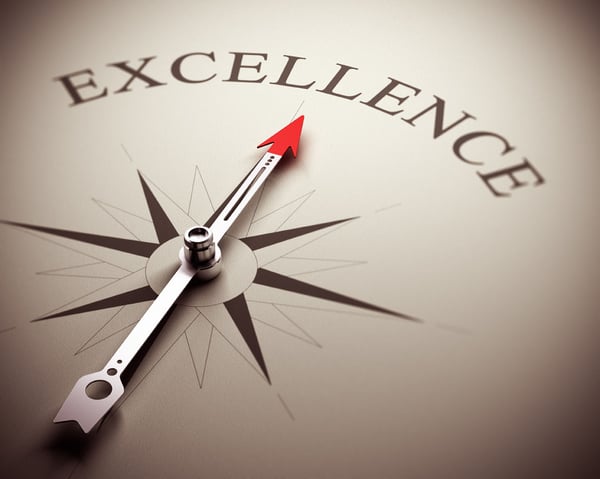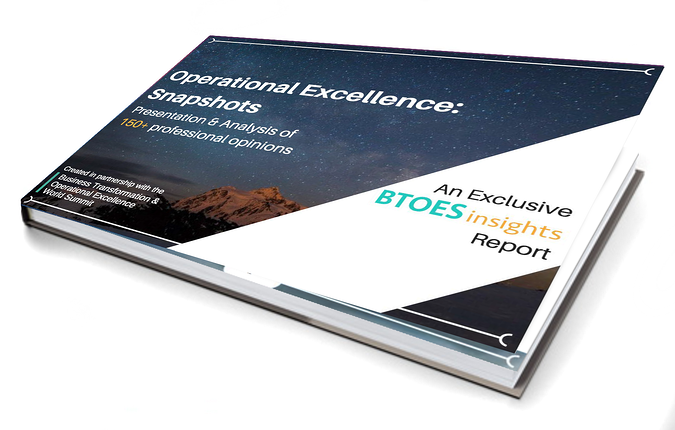BTOES From Home - SPEAKER ...
Courtesy of Nintex Pty's Paul Hsu, below is a transcript of his speaking session on 'Improve employee productivity during and post-COVID by ...
View our schedule of industry leading free to attend virtual conferences.
Each a premier gathering of industry thought leaders and experts sharing key solutions to current challenges.
Watch On-Demand Recording - Access all sessions from progressive thought leaders free of charge
from our industry leading virtual conferences.
The premier Business Transformation & Operational Excellence Conference. Watch sessions on-demand for free.
Use code: BFH1120
Delivered by the industry's most progressive thought leaders from the world's top brands.
Start learning today!
Take a look at our best definitions, learning resources & articles on Operational Excellence.

Every business has to face numerous and different challenges, both external and internal ones. For instance, speed and the ability to adapt to changing market conditions are a significant challenge for businesses. New technologies and innovation acceleration are disrupting all traditional industries and markets.
The threat of new competition (the #1 driver), rising customer expectations, expanding markets, and digitalization are the key drivers of change, and the driving force behind the ever increasing need for Operational Excellence, especially for end-to-end Business Transformation, and rapid and flexible solution offerings and execution. The rapid appearance of new business models adds fuel to increased customer expectations and requirements.
Every change in the market affects how a company operates and performs, often dramatically. And these days, it is difficult to respond to one disruption before being thrown off course by the next one. Advanced technologies, increasing digitization such as AI, Robotic Process Automation, Machine Learning, IOT, Cloud Computing, Big Data, Data Analytics, Advanced Robotics, 3D Printing, Mobile Applications are just some of the technology shifts.
But how does meaningful and effective change take place? This guide will offer you a better understanding of Operational Excellence as well as its effects, outcomes and methodologies.
Jump to any sections
What is Operational Excellence?
What do others think Operational Excellence is?
The main Principles to Achieve Operational Excellence
What are the outcomes of Effective Business and Process Improvement in your organization?
Top 3 Methodologies of Operational Excellence
Culture Transformation in Operational Excellence

Operational Excellence is the execution of the business strategy more consistently and reliably than the competition, with lower operational risk, lower operating costs, and increased revenues relative to its competitor. It is needed more than ever in today’s technology driven rapidly changing business models, which require organizations to undergo end-to-end business transformation. Operational Excellence can also be viewed as execution excellence.
Some of the key process methodologies used are Lean Manufacturing, Six Sigma, Kaizen, Hoshin Planning, Balanced Scorecard etc.
However, the focus of Operational Excellence goes beyond the traditional continuous improvement methods to a long-term change in organizational culture. Companies in pursuit of Operational Excellence do two things significantly differently than other companies: they manage their business and operational processes systematically and invest in developing the right culture.
Operational Excellence manifests itself through integrated performance across revenue, cost, and risk. It focuses on meeting customer expectation through the continuous improvement of the operational processes and the culture of the organization. The goal is to develop one single, integrated enterprise level management system with ideal flow. The second component, a culture of Operational Discipline, is commonly described as doing the right thing, the right way, every time. This culture is built upon guiding principles of integrity, questioning attitude, always problem-solving, daily continuous improvement mind-set, level of knowledge, teamwork, and process driven.
Read more: Operational Excellence Key Challenges
At heart, Operational Excellence is an element of organizational leadership that stresses the application of a numerous methodologies and tools, with a focus on the sustainable improvement of outstanding performance metrics.
Much of this management philosophy is based on earlier continuous improvement methodologies, such as Lean, Six Sigma, and the combined methodology of Lean Six Sigma. The focus of Operational Excellence goes beyond the traditional event-based model of improvement, toward a long-term change in organizational culture.

based on the work of Kevin Duggan
Design lean value streams.
Design an end-to-end lean value stream flow that starts from the time an order or request for a product/service is received from the customer until the time the product/service is delivered to the destination.
Make lean value streams flow.
Now the designed lean value stream has come to action. First of all, you should communicate it by providing formal classroom education. That way you can make sure that everyone understands the objectives and is very clear about the intended outcome of the design as well as the usage of relevant standard lean tools. Then the value stream flow can start in the implemented areas.
Make flow visual.
After designing and producing the flow, the next step os to make the flow visual. This has the purpose of employees being able to see how the processes are connected to one another and to the customer.
It has to be mentioned that there are two categories of visuals for flow in Operational Excellence: static and dynamic. Dynamic indicators enables employees the knowledge of the current status of flow and visuals that support the static design are indicators of how flow should work based on the design.
Create standard work for flow.
When a successful visual lean flow is created, the concept of standard work has to be applied to that flow. However, standard work has to me implemented not only at the process, but also between the processes.
Make abnormal flow visual.
All Employees should be able to see when or before abnormal flow happens in order to know not only how to correct abnormal flow, but also prevent future occurrences without the assistance of Management.
The flow of material to the customer is a good example of supporting the revealing of abnormal flows. By using strong visual physical indicators such as green, yellow and red zones as well as at what time the material should move from one process to the next, employees will gain a better knowledge of whether the amount of material that is present at a process or in a connection is normal or abnormal.
Create standard work for abnormal flow.
At some point, flow will eventually break down. This is why you have to be prepared for these situations and a good approach is the establishment of standard work in order to get the flow back on track. A record of the types of abnormal flow that have occurred and management's responses to them should be created by operation. On the basis of this record, a "top 10" list of what to do when abnormal flow occurs can be created.
Have employees in the flow improve the flow.
Operation should not only improve the flow's performance, but also maintain it for the purpose of supporting further growth. This can be accomplished by teaching employees to use proven continuous improvement tools, e.g. kaizen, differently. This would support and improve the flow design as well as prevent the occurrence of abnormal flow.
Perform offense activities.
When employees are able to fix autonomous flow on their own, management would not be needed anymore to run the operation and they can spend more time on growing it by performing offense activities.
5 Principles for Operational Excellence from the Lean 5S Guide
Training your Employees in Operational Excellence & Performance Improvement
The Fast Lane to Operational Excellence
The Best Operational Excellence Quotes
No Growth Strategy Without Culture - Achieving Growth through Operational Excellence
GET YOUR ORGANIZATION PREPARED FOR OPERATIONAL EXCELLENCE
The path to Operational Excellence involves dedication, patience and most of all the understanding of Continuous Improvement. If you implement the respective strategies and approaches efficiently, effective business and process improvement can support your organization in the following key areas:
Read more: Lean Business Transformation & Operational Excellence in Healthcare
Creating a Culture of Operational Discipline that leads to Operational Excellence
Lean Manufacturing
Lean Manufacturing is about eliminating waste from the manufacturing process without negatively impacting productivity. In other words, it aims to implement business processes that achieve high quality, safety and worker morale and reducing cost as well as shortening lead times at the same time.
Furthermore, waste is any activity or expenditure of resources that does not add value from the customer's point of view. In Lean manufacturing, there are seven types of waste identified:
Read more: 10 Top Tips for Implementing Lean Successfully
Read more: Creating a Lean Culture of Problem Solving
Six Sigma
Six Sigma is a set of tools and techniques for the improvement of business processes. The goal is to create customer experience improvement by means of variation's identification and elimination. This can be accomplished by the implementing DMAIC, a Six Sigma sub-methodology. DMAIC is the abbreviation for:
- Define: define the problem in order to solve it.
- Measure: measure all of your available data as well as take a more detailed look into your processes.
- Analysis: perform analysis of your findings and figure out the problem's root.
- Improvement: once you analyzed your data, find possible solutions and implement them.
- and Control: ensure to maintain your new implemented process.
Kaizen
Kaizen is Japanese and stands for "Continuous Improvement". It refers to activities aiming for the implementation of positive, ongoing changes at the work station. In other words, it is a strategy that involves all employees from every company level to work together and proactively with the goal of achieving regular, incremental improvements to the manufacturing process.
Kaizen puts emphasis on the significance of continuous improvement. It is not enough to undertake changes once. Organizations have to make an effort in continuing improvements repeatedly. Numerous companies have applied Kaizen's concept and strategy in order to increase employee productivity, reduce costs, and improve the overall customer experience.
Read more articles about Continuous Improvement:
Creating a Lean and Continuous Improvement Culture in your Business
What is the Best Way to Begin a Lean or Continuous Improvement Journey?
The 6 Mistakes Most Businesses Make When Adopting a Continuous Improvement Program
Sustaining a Continuous Improvement Culture
How to Choose Metrics to Drive Continuous Improvement
Continuous Improvement: Never be Complacent, how to stay ahead
Studies have shown that in order to survive in today and tomorrow’s business world, those organizations that have the foresight and vision to plan for the future, while quickly adapting to customer needs and utilizing new technologies to achieve operational excellence will succeed in this ever changing world.
On this page, we have compiled a number of helpful resources to build your understanding of Operational Excellence, Continuous Improvement and Lean Six Sigma.
The Myth of Continuous Improvement: Breaking the Lean Journey - Institute for Operational Excellence

To get an idea of how Operational Excellence is perceived across a huge range of industries, take a look at our FREE 6 in 1 report series, 'Operational Excellence: Snapshots', featuring the thoughts of 150+ Operational Excellence Professionals, and targeting the most pressing issues in the ecosystem.
Award-Winning Operational Excellence Case Studies
Download the free case studies now, or view the full list of award-winning Operational Excellence case studies, courtesy of the Business Transformation & Operational Excellence World Summit.
 |
 |
What is Operational Excellence? Overviews & Introductions
What is Operational Excellence? - Institute for Operational Excellence
"To leverage operations to achieve business growth, the first step is to understand what Operational Excellence really is, and then how we achieve it. Think of it as answering the question: Where will our journey of continuous improvement take us? A good answer is that our journey will take us to Operational Excellence, or the point at which —
Each and every employee can see the flow of value to the customer, and fix that flow before it breaks down.SM"
WATCH NOW: Kevin Duggan, Founder of the Institute for Operational Excellence, gives us his best definition of Operational Excellence & Operational Excellence Strategy.
Videos: Introductions to Operational Excellence
Operational Excellence 101 - Operational Excellence Consulting LLC
How to create a Culture of Operational Excellence - IndustryWeek TV
Welcome to BTOES Insights, the content portal for Business Transformation & Operational Excellence opinions, reports & news.
Insights from the most progressive thought leaders delivered to your inbox.
Insights from the world's foremost thought leaders delivered to your inbox.
Being a hero is all about creating value for others. Please invite up to 5 people in your network to attend this premier virtual conference, and they will receive an invitation to attend.
If it’s easier for you, please enter your email address below, and click the button, and we will send you the invitation email that you can forward to relevant people in your network.
View our schedule of industry leading free to attend virtual conferences. Each a premier gathering of industry thought leaders and experts sharing key solutions to current challenges.
View Schedule of EventsWatch On-Demand Recording - Access all sessions from progressive thought leaders free of charge from our industry leading virtual conferences.
Watch On-Demand Recordings For FreeDelivered by the industry's most progressive thought leaders from the world's top brands. Start learning today!
View All Courses NowThe premier Business Transformation & Operational Excellence Conference. Watch sessions on-demand for free. Use code: BFH1120
Watch On-DemandInsights from the most progressive thought leaders delivered to your inbox.
Insights from the world's foremost thought leaders delivered to your inbox.
Being a hero is all about creating value for others. Please invite up to 5 people in your network to also access our newsletter. They will receive an invitation and an option to subscribe.
If it’s easier for you, please enter your email address below, and click the button, and we will send you the invitation email that you can forward to relevant people in your network.
Courtesy of Nintex Pty's Paul Hsu, below is a transcript of his speaking session on 'Improve employee productivity during and post-COVID by ...
Read this article about HP, Best Achievement in Operational Excellence to deliver Digital Transformation, selected by the independent judging panel, ...
Read this article about BMO Financial Group, one of our finalists, in the category Best Achievement in Operational Excellence to deliver Digital ...
Read this article about Cisco, one of our finalists, in the category Best Achievement of Operational Excellence in Internet, Education, Media & ...